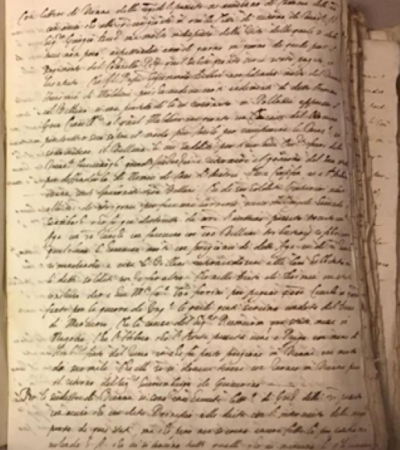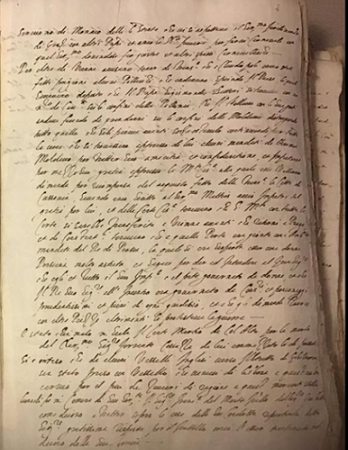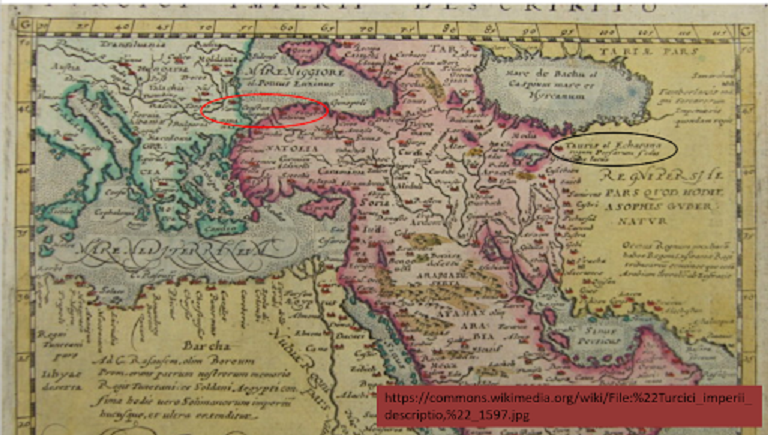[Brendan Dooley and Davide Trentacoste]
A newsletter sent to the Tuscan court from Venice, dated 12 February 1600, carried the following report, no doubt intended to raise some eyebrows: “From Constantinople they write that an ambassador had arrived at the imperial gate [i.e., the Sublime Porte] and this ambassador was discovered to be a very astute and wise Persian woman, sent by the King of Persia”
[Florence, Archivio di Stato, Mediceo del Principato, Volume 3087, fol. 2r, dated 12 February 1600]


Her message: “to tell the Grand Turk [Mehmed III at this time] that he and his whole empire were currently ruled by women, and that her King on the other hand [i.e., the king of Persia] was ruled by Counsellors and very prudent persons full of judgment [presumably like herself], and that he now demanded Tauris and other places or there would be war.”
In fact, Tauris [modern Tabriz, in Iran], shown encircled in black on the map below from around that time by Giovanni Magini, had just been taken over by the Ottomans in 1585, much to the indignation of the Persians, who would actually get it back only in 1603, and lose it again a couple decades later. Constantinople is encircled in red.

The Shah who ruled in Persia at the time was Shāh ʿAbbās I the Great (r. 1587-1629). He had come to power by dethroning his father, Shāh Mohammad Khodābande (r. 1578-1587), in a moment that was critical for the Safavid dynasty. Indeed, since 1578 Persia had been facing a tough war against the Ottomans for control of the Caucasus and surrounding regions, and Persia was losing it. Despite the valour of the Persian soldiers, which was also known in Europe at least since the end of the 15th century, so much so that Machiavelli (but also many others) mentioned it in a number of works, the greater organisation and capacity of the Ottoman army combined with a serious internal crisis within the Persian state, got the better of the Safavid forces. At the time of his accession to the throne, Shāh ʿAbbās was thus faced with the overwhelming Ottoman forces sweeping through his Caucasian territories and at the same time having to defend his eastern borders from the constant incursions of the Uzbeks. Thus, he was forced to make a costly peace with the Sultan in which he officially ceded all the provinces that Persia had already lost, including Tabriz. Peace was concluded in 1590 with the Treaty of Constantinople, after which Shāh ʿAbbās devoted himself to restoring order in the East and reorganising the state. His efforts were so energetic and effective that by the end of the century Shāh ʿAbbās felt strong enough to make bold demands for the return of the provinces to the Ottoman sultan.
Returning to our Persian ambassador and her bold statements we can imagine that the reference to the Grand Turk being ruled by women, not in a good sense, was a reference to the infamous Serraglio, containing his many wives and, many, shall we say distractions. Contrast this with the much more serious Persians, she’s saying, and one may suppose, giving herself as an example of a serious civil servant. A remarkable testimony of important diplomatic and political roles being distributed on a gender equal basis, which becomes news due to being not normal. It is indeed intriguing to observe that despite the likely provocative intent of sending a woman as an ambassador, the Shah's selection was based on her intelligence. This decision indicates that the Shah sought to avoid any potential mishaps or embarrassment, choosing someone who could represent him competently and without any flaws.
On the other hand was the event just some wishful thinking, considering the exotic setting in the Grand Turk’s court? Every news writer at the time knew this cardinal rule of reporting; namely, «what the customer doesn’t know, the reporter gets away with,» i.e., that the farther away the news location was from the reader, not only, the more foreign-sounding were things likely to be, but also, the less verifiable.
In any case, it is interesting to note that the information that arrived in Florence from Venice probably came from the Empire, specifically from Vienna, as can be seen from the fact that the document that arrived from Venice clearly states several times that the information had been gathered in Vienna. And indeed, a document in the Vienna State Archives, the Imperial Archives, bearing a date a few weeks before the Venetian notice, contains a more extensive and thorough description of the ambassador’s arrival in Constantinople and the “geopolitical” situation in the Caucasus and the Shah’s intentions [Haus-, Hof- und Staatsarchiv Wien, Handschriften Weiß, 290/9 (ff. 883a-b/884a)]. It cannot therefore be ruled out that the avviso from Venice contained only a summary of what was described in the imperial dispatch, which was probably the ‘original’ document concerning the female ambassador’s affair. If this were the case, then the news from Venice would not be a confirmation of the Imperial document, but only its summary. That news about the Levant sent from Venice to Florence did not actually come directly from the Levant but rather from Vienna (or Prague or even Salzburg), should come as no surprise: in fact, Venice was a major centre of arrival, collection and sorting of information from all over the world, as were the great imperial cities of the court at the centre of Christian power (also like Rome). It was therefore quite common to find news from the Levant arriving in Florence from Prague or Vienna, just as it was common to gather information about northern Europe in Venice.
If this were the case, it should probably raise doubts about the veracity of the story since, apart from these two clearly related documents, there is no confirmation of this story in both Ottoman and Persian sources and chronicles. Indeed, already by the end of the 16th century, many rumours were circulating in Europe about Shah Abbas I, most of them false and spread to make him appear as a good ruler allied to the Christians, even though he was as much a Muslim king as the Ottoman Sultan. For instance, in the very early years of the 17th century, there were persistent rumours about his love for Christians, that he wore a cross hidden in his clothing, or even that he was secretly a Christian. These accounts were obviously false and were already discredited by the first Discalced Carmelite missionaries who established a mission in Isfahan after 1604. However, at the end of the 16th and beginning of the 17th century, many in Europe believed these things, perhaps even some Catholic rulers who wanted to ally themselves with him and who therefore needed to believe that, although he was a Muslim, he was still a good potential ally of Christianity. Moreover, the Shah was believed to be very brave and bold, and consequently a story such as the one reported in the news from Constantinople seemed guaranteed to make the Persian king look favourable in the eyes of the Christians, and indeed, the supposed threat seemed to be something that he, a ruthless and contemptuous king, was capable of making. No doubt, an extremely curious European readership is targeted here.
However, we must also consider the fact that the lack of confirmation from Safavid or Ottoman sources does not necessarily mean that we can consider this story as false or at least partially false. In fact, the lack of such a story in Ottoman and Safavid chronicles could be due to many reasons, including the fact that reporting on such a matter was not common for Safavid chroniclers and court writers, while on the other hand the Ottomans may have preferred not to keep records on a matter such as this, intended to humiliate them.
The question remains open.
FURTHER READING
Sinem Arcak Casale, Gifts in the Age of Empire Ottoman-Safavid Cultural Exchange, 1500–1639, Chicago & London: The University of Chicago Press, 2023.
Colin P. Mitchell, The Practice of Politics in Safavid Iran. Power, Religion and Rhetoric, London-New York: I. B. Tauris, 2009 (in particular 176-182).
Davide Trentacoste, “All the grand dukes’ men. An overview of the Persian information network of Medici Tuscany between 1600 and 1639”, Mediterranean Historical Review, 38, 1 (2023): 93-111. https://doi.org/10.1080/09518967.2023.2190573
Ernrst Tucker, “Safavid relations with Muslim neighbors”, Rudi Matthee (ed.), The Safavid World, Abingdon and New York: Routledge, 2021, pp. 539-555.
Daniel J. Vitkus, “Early Modern Orientalism: Representations of Islam in Sixteenth- and Seventeenth-Century Europe” in D.R. Blanks et al. (eds.), Western Views of Islam in Medieval and Early Modern Europe 1999, chap. 11.
